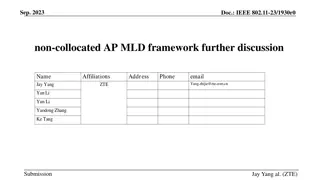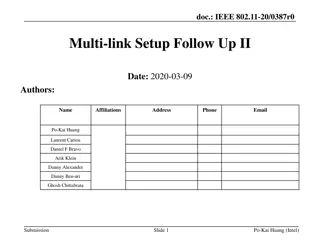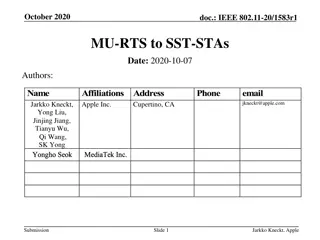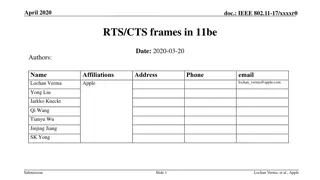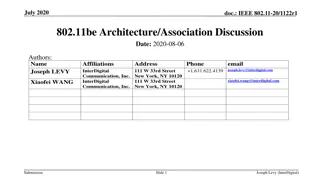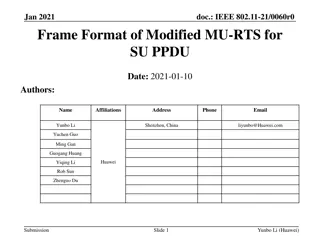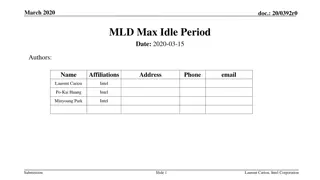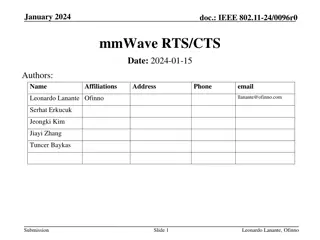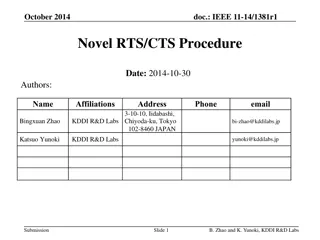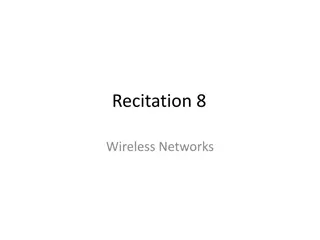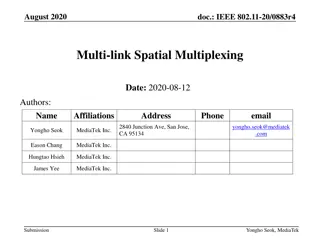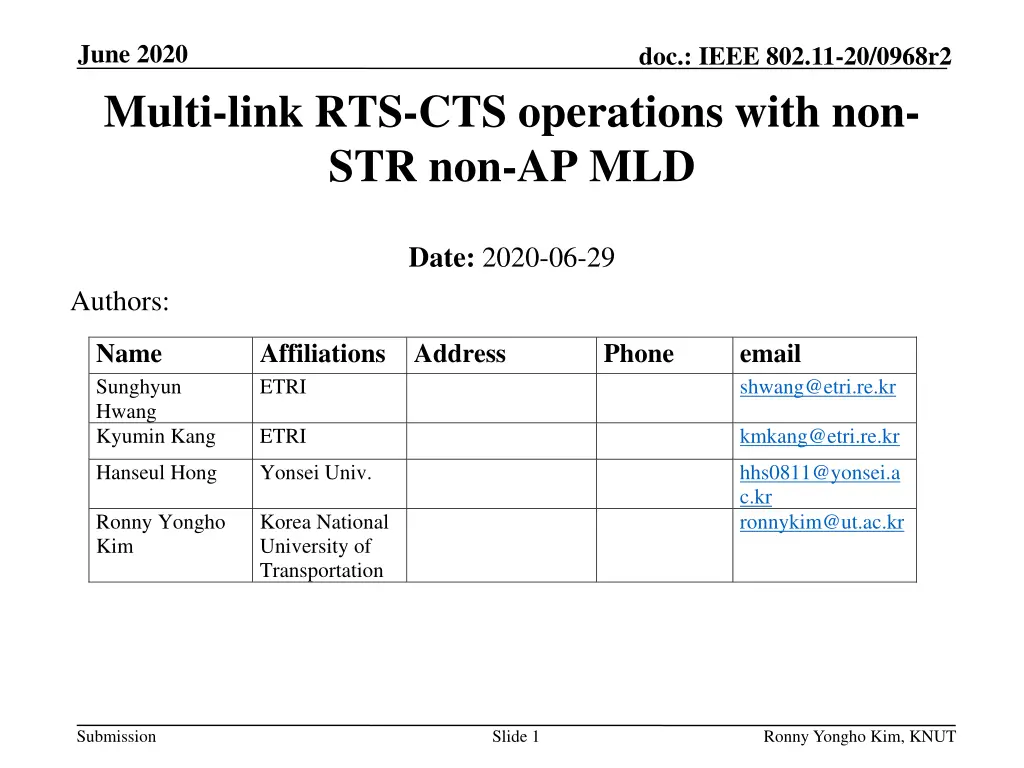
Multi-Link RTS-CTS Operations in IEEE 802.11-20/0968r2
Explore the challenges and solutions in the multi-link RTS-CTS operations with non-STR, non-AP MLD. Topics include PPDU end-time alignment, RTS-CTS transmission issues, synchronized and semi-synchronized procedures. Stay informed about advancements in non-STR multi-link performance.
Download Presentation

Please find below an Image/Link to download the presentation.
The content on the website is provided AS IS for your information and personal use only. It may not be sold, licensed, or shared on other websites without obtaining consent from the author. If you encounter any issues during the download, it is possible that the publisher has removed the file from their server.
You are allowed to download the files provided on this website for personal or commercial use, subject to the condition that they are used lawfully. All files are the property of their respective owners.
The content on the website is provided AS IS for your information and personal use only. It may not be sold, licensed, or shared on other websites without obtaining consent from the author.
E N D
Presentation Transcript
June 2020 Multi-link RTS-CTS operations with non- STR non-AP MLD doc.: IEEE 802.11-20/0968r2 Date: 2020-06-29 Authors: Name Sunghyun Hwang Kyumin Kang Affiliations Address ETRI Phone email shwang@etri.re.kr ETRI kmkang@etri.re.kr Hanseul Hong Yonsei Univ. hhs0811@yonsei.a c.kr ronnykim@ut.ac.kr Ronny Yongho Kim Korea National University of Transportation Submission Slide 1 Ronny Yongho Kim, KNUT
June 2020 doc.: IEEE 802.11-20/0968r2 Introduction The multi-link operation includes the operation of non- STR multi-link operation[1]. Several presentations considered RTS-CTS mechanism of multi-link with non-STR non-AP MLD [2], [3]. This presentation continues to discuss the issue. Submission Slide 2 Ronny Yongho Kim, KNUT
June 2020 Recap: multi-link operation and channel access doc.: IEEE 802.11-20/0968r2 Previous submissions proposed the PPDU end-time alignment operation when multi-link operation is performed with non-STR non-AP MLD [2], [3]. Tx PPDU from AP to STA MLD Tx PPDU from AP to STA MLD Link 1 BA Tx PPDU from AP to STA MLD Link 2 Busy TX PPDU from STA1 BA Align PPDU end time Submission Slide 3 Ronny Yongho Kim, KNUT
June 2020 RTS-CTS transmission issue in non-STR operation doc.: IEEE 802.11-20/0968r2 RTS-CTS mechanism on the second link may not be allowed in non-STR multi-link operations. RTS TX PPDU from AP1 to STA1 AP MLD1 (AP1) STA MLD1 (STA1) Link 1 CTS BA Non STR Link Pair RTS PPDU AP MLD1 (AP2) Link 2 Busy STA MLD1 (STA2) CTS PPDU transmission is not possible AP knows the duration of busy period STA may not respond with a CTS [SFD] When a STA in a non-STR MLD receives an RTS addressed to itself, if the NAV of the STA indicates idle but another STA in the same MLD is either a TXOP holder or a TXOP responder, the STA may not respond with a CTS frame. There is no clear rule for RTS frame transmission on non- STR multi-link performance degradation Submission Slide 4 Ronny Yongho Kim, KNUT
June 2020 doc.: IEEE 802.11-20/0968r2 Synchronized ML RTS-CTS procedure Whenever possible, synchronized RTS transmission is a simple solution for non-STR AP MLD. There are proposals for a synchronized ML transmission. RTS TX PPDU from AP1 to STA1 AP MLD1 (AP1) STA MLD1 (STA1) Link 1 CTS BA Non STR Link Pair RTS TX PPDU from AP2 to STA2 AP MLD1 (AP2) Link 2 Busy STA MLD1 (STA2) CTS BA However, if channel access procedure on the other(second) link is taking too much time after a successful channel access on one link, it would be beneficial to consider semi- synchronized ML transmission. Submission Slide 5 Ronny Yongho Kim, KNUT
June 2020 Semi-synchronized ML RTS-CTS procedure for non-STR multi-link operation There are several cases for a semi-synchronized ML RTS- CTS procedure Case1: Second link s backoff success < First link s CTS TX start time Case2: Second link s backoff success < First link s PPDU TX start time Case3: Second link s backoff success > First link s PPDU TX start time doc.: IEEE 802.11-20/0968r2 RTS TX PPDU from AP1 to STA1 AP MLD1 (AP1) STA MLD1 (STA1) Link 1 CTS BA AP MLD1 (AP2) Case 1 Link 2 Busy STA MLD1 (STA2) AP MLD1 (AP2) Case 2 Link 2 Busy STA MLD1 (STA2) AP MLD1 (AP2) Case 3 Link 2 Busy STA MLD1 (STA2) Submission Slide 6 Ronny Yongho Kim, KNUT
June 2020 Semi-synchronized ML RTS-CTS procedure for non-STR multi-link operation doc.: IEEE 802.11-20/0968r2 Case1: Second link s backoff success < First link s CTS TX start time Do not transmit RTS on the second link (link 2). During STA1 s CTS transmission, AP2 can transmit CTS-to-Self for NAV setting. Alternatively, AP2 can transmit a PPDU on the second link using a synchronized ML transmission. SIFS SIFS RTS TX PPDU from AP1 to STA1 AP MLD1 (AP1) STA MLD1 (STA1) Link 1 CTS BA Non STR Link Pair CTS To Self TX PPDU from AP2 to STA2 AP MLD1 (AP2) Link 2 Busy STA MLD1 (STA2) BA Submission Slide 7 Ronny Yongho Kim, KNUT
June 2020 Semi-synchronized ML RTS-CTS procedure for non-STR multi-link operation doc.: IEEE 802.11-20/0968r2 Case2: Second link s backoff success < First link s PPDU TX start time Do not transmit RTS on the second link (link 2). AP2 can transmit a PPDU on the second link using a synchronized ML transmission. AP2 should transmit non-HT PPDU for better protection because the second link is not protected by RTS-CTS. SIFS SIFS RTS TX PPDU from AP1 to STA1 AP MLD1 (AP1) STA MLD1 (STA1) Link 1 CTS BA Non STR Link Pair TX PPDU from AP2 to STA2 Non-HT PPDU (Legacy PPDU) AP MLD1 (AP2) Link 2 Busy STA MLD1 (STA2) BA Submission Slide 8 Ronny Yongho Kim, KNUT
June 2020 Semi-synchronized ML RTS-CTS procedure for non-STR multi-link operation doc.: IEEE 802.11-20/0968r2 Case3: Second link s backoff success > First link s PPDU TX start time Do not transmit RTS on the second link (link 2). AP2 transmits a PPDU after the transmission start time of PPDU on link 1. (Semi-synchronized ML transmission) AP2 should transmit non-HT PPDU for better protection because the second link is not protected by RTS-CTS. RTS TX PPDU from AP1 to STA1 AP MLD1 (AP1) STA MLD1 (STA1) Link 1 CTS BA Non STR Link Pair TX PPDU from AP2 to STA2 Non-HT PPDU (Legacy PPDU) AP MLD1 (AP2) Link 2 Busy STA MLD1 (STA2) BA Submission Slide 9 Ronny Yongho Kim, KNUT
June 2020 doc.: IEEE 802.11-20/0968r2 Conclusion RTS-CTS mechanism for Non-STR MLD was discussed. In case of Non-STR MLD, when a channel access on one link of a non-STR link pair is successful, there are several cases for RTS-CTS ML transmission on the other link. Case1: Second link s backoff success < First link s CTS TX start time Case2: Second link s backoff success < First link s PPDU TX start time Case3: Second link s backoff success > First link s PPDU TX start time For all cases considered in this presentation, in case of transmitting PPDUs to non-STR non-AP MLD, it is recommended not to transmit RTS frame on the second link when using a semi-synchronized ML transmission. Submission Slide 10 Ronny Yongho Kim, KNUT
June 2020 doc.: IEEE 802.11-20/0968r2 Reference [1] 11-19/1262r6 Specification Framework for TGbe [2] 11-19/1405 Multi-Link Operation Channel Access Discussion, Sharan Naribole (Samsung) [3] 11-19/1546 Legacy Performance Impact on Multi-link Operation, Yongho Seok (MediaTek) [4] 11-19/1916 MLO-Asynch-Qsynch-Synch, Matthew Fischer (Broadcom Inc) [5] 11-19/1917 Considerations for multi-link channel access without simultaneous TX/RX capability, Insun Jang (LG Electronics) [6] 11-19/1541 Performance aspects of Multi-link operations with constraints, Dmitry Akhmetov (Intel) Submission Slide 11 Ronny Yongho Kim, KNUT
June 2020 doc.: IEEE 802.11-20/0968r2 Straw Poll #1 Do you agree to add the following to R1 of 11be SFD: For non-STR non-AP MLD, when an RTS/CTS mechanism is used on one link, the PPDU on the other link shall be transmitted without sending an RTS frame. Submission Slide 12 Ronny Yongho Kim, KNUT
June 2020 doc.: IEEE 802.11-20/0968r2 Straw Poll #2 Do you agree to add the following to R1 of 11be SFD: For non-STR non-AP MLD, when an RTS/CTS mechanism is used on one link, when the PPDU transmission should be protected on the other link, a CTS-to-Self frame should be transmitted before the PPDU transmission and/or the PPDU should use non-HT PPDU format. Submission Slide 13 Ronny Yongho Kim, KNUT
June 2020 doc.: IEEE 802.11-20/0968r2 Straw Poll #3 Do you agree to add the following to R1 of 11be SFD: For non-STR non-AP MLD, when an RTS/CTS mechanism is used on one link, the PPDU transmission on the other link shall be synchronized with or started after the PPDU transmission on one link. Submission Slide 14 Ronny Yongho Kim, KNUT

